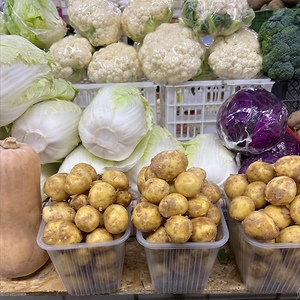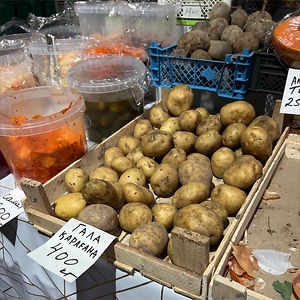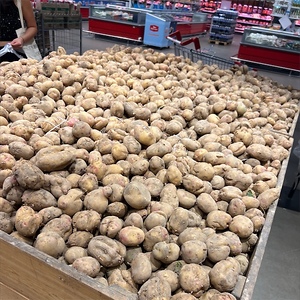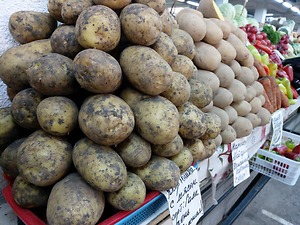


Gala Potatoes
Estimated Inventory, 1 Lb : 0
Description/Taste
Gala potatoes are medium to large tubers, averaging 7 to 8 centimeters in length and 5 to 6 centimeters in diameter, and have an oval to round, curved shape. The uniform tubers have semi-thick, golden skin with a firm, smooth, slightly flaky texture. The surface also bears a few small, shallow eyes that do not affect the tuber’s even appearance. Underneath the skin, the yellow flesh is dense, moist, and starchy with a fine-grained consistency. Gala potatoes develop a tender texture and retain their shape once cooked, containing a mild, sweet, subtly nutty, and earthy flavor.
Seasons/Availability
Gala potatoes are available year-round.
Current Facts
Gala potatoes, botanically classified as Solanum tuberosum, are a famous early to mid-season German variety belonging to the Solanaceae or nightshade family. The uniform tubers are considered an all-purpose cultivar with the ability to be utilized in a wide range of dishes without compromising flavor or texture. Gala potatoes are one of the most popular varieties among home gardeners throughout Europe and Central Asia, valued for their fast-growing nature, high yields, disease resistance, and mild flavor. Commercial growers also favor this cultivar for its uniform appearance, making it easy to quickly wash, pack, and process the tuber for specific uses.
Nutritional Value
Gala potatoes are an excellent source of fiber to regulate the digestive tract and are a rich source of vitamin C to protect the cells against free radicals by strengthening the immune system and reducing inflammation. The tubers are also a good source of potassium to balance fluid levels in the body, contain iron to build the protein hemoglobin to transport oxygen in the blood, and provide lower amounts of B vitamins, magnesium, and folate.
Applications
Gala potatoes are a versatile variety well-suited for cooked applications such as steaming, boiling, frying, and roasting. The tuber’s firm flesh holds its shape once cooked, and the skin is easy-to-peel and won’t discolor once sliced. Gala potatoes can be used in any recipe calling for table potatoes. The potatoes can be boiled whole and served as a simple side dish, or the boiled potatoes can be mashed, riced, or pureed to create a smoother consistency. The tubers can also be sliced into strips and cooked into fries, cubed and roasted, shredded and fried into patties, or cut and tossed into soups and stews. In Germany, Gala potatoes are frequently incorporated into bratkartoffein or pan-fried potatoes, and kartoffel kloesse, boiled potato dumplings coated in a rich brown butter sauce. They can also be stuffed with ground meats and rice and baked. Gala potatoes pair well with spices such as marjoram, paprika, thyme, nutmeg, and rosemary, meats such as bacon, beef, and turkey, tofu, onions, garlic, root vegetables such as carrots, parsnips, and beets, and cheeses such as cheddar, mozzarella, gruyere, and parmesan. Whole, unwashed Gala potatoes will keep 3 to 5 weeks when stored in a cool and dark place.
Ethnic/Cultural Info
Gala potatoes have become a favored potato variety used in beshbarmak, Kazakhstan’s national dish. Beshbarmak roughly translates from Kazakh to mean “five fingers” and is traditionally served for special occasions and dinner parties. It was also a dish passed down between generations as a part of family heritage. Cooking and serving quality beshbarmak was regarded as a necessary skill for young women to acquire, especially when they were entering into marriage. Beshbarmak was historically cooked by the nomadic tribes and consisted of meat, pasta, onions, and available vegetables. One unique ingredient frequently used in beshbarmak is qazy, also known as qazi, a sausage-like meat made from horse ribs and fat, stuffed into natural horse intestine with flavorful spices. The ribs are cooked for several hours, creating a tender texture, and they can either be served whole on top of the dish or hand-sliced into smaller pieces. Qazy is considered a delicacy in Central Asia, highly valued for its high protein content. Beshbarmak is also comprised of handmade dough or pasta rolled into flat squares and is served with a mixture of onions, broth, and spices. In the modern-day, there are many varieties of beshbarmak served throughout Central Asia with varying ingredients such as rice instead of pasta, lamb instead of qazy, and the dish is sometimes served with boiled potatoes and carrots. Gala potatoes have become a popular addition to beshbarmak as the tubers can be stored for extended periods, are transportable, flavorful, and filling.
Geography/History
Gala potatoes were developed in 1992 by Norika, a seed potato company based in Germany. The variety was created from a cross between leyla potatoes and a tuber known as 2.6 720-86 and was selected for its high yields, disease resistance, extended storage capabilities, and uniform shape. Gala potatoes quickly spread in popularity among European growers and home gardeners throughout the 20th century, and later in 2008, the variety was added to the State Register of Russia. Today Gala potatoes can be found in Eastern Europe, in the Northern and Central regions of Russia, and throughout Central Asia. The Gala potatoes featured in the photograph above were found through a Kazakh vendor at the Green Market in Almaty, Kazakhstan. The potatoes were grown on a farm in Northern Kazakhstan near the Russian border and were transported to the Green Market for culinary sale.
Recipe Ideas
Recipes that include Gala Potatoes. One











